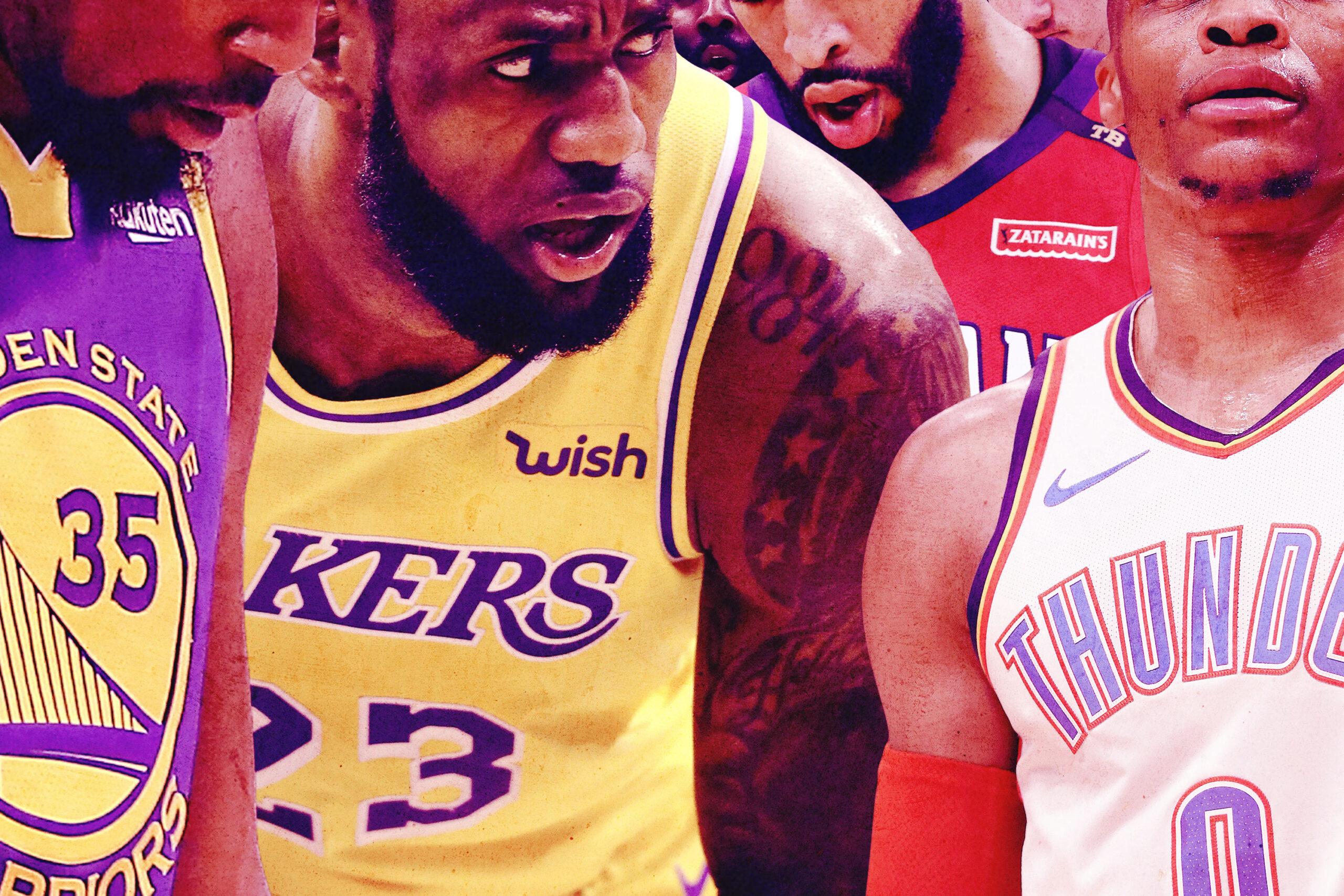
Led by dark-horse MVP candidate Nikola Jokic, the Denver Nuggets have overcome injuries and a recent history of mediocrity to sit atop the Western Conference, ahead of prospective superteams and even the Golden State Warriors. But two bad weeks is all it would take to send the Nuggets tumbling toward the bottom of the standings. That’s because just seven and a half games separate the first- and 14th-place teams in the Western Conference—an astoundingly small number more than a third of the way through the season.
That compression makes the last few playoff spots, meanwhile, look like a nightly game of musical chairs, as a hectic mix of teams battles to make the postseason field. The regular season still features four more months of twists and slumps, but it’s already clear that something special is happening out West. No conference under the current alignments has ever had this much parity at this point in the season—which, if it continues, could create a historically tight playoff race and complicate trade discussions leading up to the February deadline.
To test the idea that the standings in the West are tighter than any in recent history, we looked at the first 30 games for every team since 2004-05, when the then–Charlotte Bobcats joined the NBA and boosted each conference to 15 teams. (Yes, some teams this season have slightly exceeded 30 games, but for the purposes of more logical comparisons across seasons, we chose a standard 30 for everyone.) Unsurprisingly, teams’ records under these criteria varied across a wide range, from the 29-1 mark from the 2015-16 Warriors at the top to the 1-29 atrocity the 2015-16 76ers barfed onto the Wells Fargo Center floor at the bottom.
Looking at the two conferences in each season doesn’t reveal any particular pattern; some seasons have more parity, some less, with no noticeable rhyme or reason as to when or why. But compared with their predecessors, the 2018-19 Western standings stand out; the standard deviation in wins in the West this season (a measure of how loosely or tightly packed a group of numbers is) is lower than all the rest.
What this means is that since the NBA expanded to 30 teams, no conference’s teams have been so closely clumped together this late. Simply skimming the standings each morning would reveal this notion, anyway—a whopping 14 Western teams won at least 14 of their first 30 games (no previous conference in the 30-team era had seen more than 12 teams do so), so only the Suns fall below the threshold of a playoff contender.
Those wins all have to come from somewhere, and the sheer level of competitiveness from top to non-Phoenix bottom has dragged the best teams’ win totals down toward the middle. Denver paced the West with 21 wins through 30 games, tied for the fewest wins for the Western Conference leader since the expansion to 30 teams. (The East went lower in 2006-07, when its leader, Detroit, won just 19 of 30 games.)
A compressed range of wins bunches all the teams together—in this case, 14 teams packed into a width of seven games in the wins column—and makes for fascinating permutations in the standings each morning. A single undefeated or winless week can have an enormous impact on a team’s standing. Just this month, the Rockets fell from eighth place on the morning of December 2 to the 14th place on the morning of December 9. The Timberwolves managed the same feat from December 7-14, sliding from eighth to 14th in that span. Conversely, the Rockets and Spurs both rose from 14th to seventh within the past two weeks, while the Jazz this month have zigzagged from 10th to 14th to 10th to 14th again.
Only three West teams have not held a playoff spot at some point in December: the Suns; the Jazz, who have suffered the most difficult schedule of any team thus far and therefore have ample room for improvement; and the Pelicans, who employ Anthony Davis and therefore have more reason than almost anyone to reenter the top eight.
Across the Mississippi River, meanwhile, the East hasn’t enjoyed the same level of consistent competitiveness, with the Raptors racing to a 23-7 start and a collection of teams Tryin’ for Zion at the rear. Four Eastern teams already hold less than a 1 percent chance of making the playoffs. But in the East, too, the early playoff race has taken considerable, if less voluminous, shape; in this case, would-be contenders haven’t created any meaningful separation because every team outside the top five is so mediocre (at best) to bad (at worst, and more frequently).
Normally, teams in this position might not care much about chasing a playoff spot because what’s the point of losing a first-round gentleman’s sweep to a vastly superior squad, but the members of this year’s group have reason to try. The Pistons, Hornets, Magic, and Nets are in the midst of playoff droughts, having combined to win one playoff series since 2010, while the Wizards have already added a win-now piece in Trevor Ariza in their desperate push for another 40-something-win season and early playoff exit. There’s also less of a penalty than ever for just missing a playoff spot, thanks to the flattening of draft lottery odds next spring.
This odd arrangement yields a possible dearth of appealing options at this season’s trade deadline. There aren’t many obvious sellers, and those few teams that qualify—Phoenix, Chicago, Atlanta, Cleveland, and New York—don’t have many obvious difference-making players. When Kevin O’Connor laid out possible trade permutations earlier this week, the players he mentioned who might move to contenders were nobody from the Suns, with Ariza gone; Jabari Parker from the Bulls; Kent Bazemore, Jeremy Lin, and Dewayne Dedmon from the Hawks; Kevin Love, Rodney Hood, Alec Burks, and J.R. Smith from the Cavaliers; and Courtney Lee and Tim Hardaway Jr. from the Knicks. Besides Love, whose contract and injury problems might render him untradable, that’s not a particularly compelling group of players.
Even if deadline additions rarely lead teams to the Finals, the annual event brings more excitement when it curates a flurry of moves. The current composition of the league doesn’t seem inclined to produce an especially lively deadline, or at least a traditional one with a clear dichotomous split between buyers and sellers. Perhaps the leaguewide parity means more trades this season will involve shuffling rosters with direct rivals; a trade that sent, for instance, Kentavious Caldwell-Pope from the Lakers to the Rockets could make sense for both sides, even if two teams fighting for the same playoff real estate might not want to help each other in normal circumstances.
Of course, with seven weeks still to go before the February 7 trade deadline, the two conferences might sort into more natural tiers before teams must make trade decisions. In the West, maybe the Kings will slump and decide they’re still one year away, or maybe the Clippers’ losing streak will continue and a slew of useful veterans will become available. It would take just one bad month for New Orleans for Anthony Davis rumors to congeal into a potential deadline blockbuster.
But at the moment, none of those scenarios seems especially likely, as every Western team, examined independently, has reason for optimism. The problem is not every team can capitalize on that possibility; a half-dozen decent teams are, in fact, guaranteed to miss the playoffs. And with the trade deadline coming two weeks earlier than it had traditionally been scheduled after a change went into effect for the 2017-18 season, mugwumps on the trading fence will have less time to commit to selling.
At the same time, with such a tight bunching in the standings, even a semi-meaningful upgrade could boost a team several spots. The Pelicans could add a reliable wing and jump from 12th to sixth, but the very dynamic that creates such urgency has also left few reliable wings available for the taking. It’s a strange and twisty set of circumstances, but that part, at least, coheres—the entire conference this season is strange and twisty, too.

